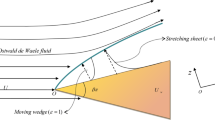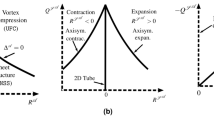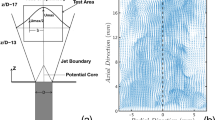Abstract
WHEN a turbulent jet flows through an enveloping fluid, the interface breaks up into vortices. The development of such vortices for the flow of a confined jet issuing from a sluice-way and diffusing into water downstream has previously been described1. The vortices grow as they flow downstream, and eventually extend throughout the entire height of the circulation zone. The mixing produced by these vortices causes the jet to expand until its upper limit momentarily reaches the free surface, where it divides and a stagnation point develops.
This is a preview of subscription content, access via your institution
Access options
Subscribe to this journal
Receive 51 print issues and online access
$199.00 per year
only $3.90 per issue
Buy this article
- Purchase on Springer Link
- Instant access to full article PDF
Prices may be subject to local taxes which are calculated during checkout
Similar content being viewed by others
References
Naib, S. K. A., Nature, 210, 694 (1966).
Author information
Authors and Affiliations
Rights and permissions
About this article
Cite this article
NAIB, S. Unsteadiness of the Circulation Pattern in a Confined Liquid Jet. Nature 212, 753–754 (1966). https://doi.org/10.1038/212753a0
Issue Date:
DOI: https://doi.org/10.1038/212753a0
Comments
By submitting a comment you agree to abide by our Terms and Community Guidelines. If you find something abusive or that does not comply with our terms or guidelines please flag it as inappropriate.



